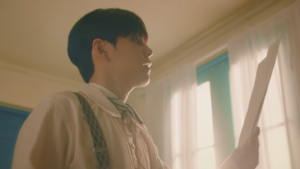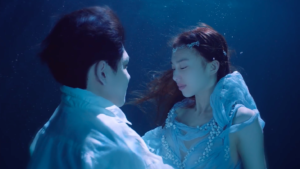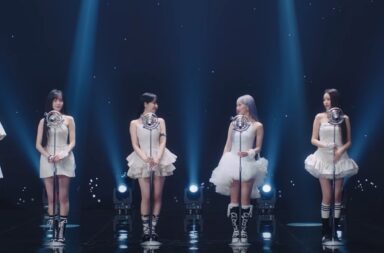
Fittingly, as the last remaining active member, Wonpil was also the only member who had yet to release his own music, making now the perfect time for him to finally debut as a soloist and usher in a new era for the group. While fans of Day6 are used to seeing Wonpil behind the keyboard, his first foray into his own spotlight with the release of his first full-length album, Pilmography, and accompanying MV for title track “Voiceless” couldn’t have come at a better time.
“Voiceless” is almost exactly what avid listeners of Day6 would expect from Wonpil, but not in a disappointing or predictable way. An upbeat but emotional ballad, the track is a perfect vessel for Wonpil to showcase what he is best known for: his powerful, striking, and yet gentle singing voice. Ironically, the name of the track is hardly suggestive of its nature, as Wonpil commandingly yet sweetly sings of a relationship he decides to end for the benefit of the other person, rather than himself:
“This is my confession, hoping for your happiness
Let’s put an end to us, let’s not see each other again
The longer we’re together
I see you get tired of us
I promise myself, today, I’d let you go”
Wonpil’s vocals are accompanied by full, at times swelling, piano and orchestral elements that when combined together produce a swaying effect to make the track even more dynamic and compelling. The track’s MV accompanies these swaying and swelling instrumentals with breathtaking visuals and back-and-forth scenes, adding to the narrative and making it that much more impactful.
Day6’s MVs often take the emotional, literal route to somewhat realistically convey the meaning and plot of their songs, shot-by-shot, line-by-line. It is a formula that has worked quite well for them since their inception, most notably in the MV for “You Were Beautiful.” Here, Wonpil largely takes on the same kind of approach for “Voiceless,” only this time mixing the literal with the fantastical, and dreams with reality.
While the strength of the MV doesn’t necessarily lie in the breadth and depth of the actual plot itself, the visual elements that serve to tell it are breathtaking and nearly impossible to look away from. After the title card appears, a quote flickers and it reads:
Blue eyes, act to remind me of the ocean
There stood before me – a mermaid

Wonpil appears in a breezy, warmly-tinted room covered floor to ceiling with old books, drawings, and letters as he types another quote in reference to the mermaid featured in the MV into his typewriter. It is immediately obvious that one of the MV’s most prominent focal points is its production design. Aside from the detail of the room filled with books and letters, and the soft beams of light that bathe over Wonpil to emphasize both the sincerity and wistfulness of the track, the scenes in which the room begins to fill with water are magnificent pieces of visual art on their own.
When Wonpil finally finds himself completely underwater, face to face with the mermaid who is also the subject of his writing and his love, the beauty of each shot that follows reaches new heights. Each piece of the set within the book-filled room moves gently and lightly along with Wonpil and the water, and the delicacy of Wonpil’s feelings toward the mermaid becomes even more prominent as the water makes him appear even more ethereal.
As the MV progresses, the focus on the set and props keeps the momentum of the visual narrative going, to the point where each subsequent shot is practically irresistible, hinting at what may happen next between Wonpil and the mermaid. When the water disappears, it leaves every object in the room soaked and ruined, like Wonpil himself. Focused shots of the dripping typewriter and soaked books don’t necessarily convey what exactly is going on, but they do hint at where things in the storyline may be going. When the water returns, it is a brief signal of hope that Wonpil may be reunited with his love once again.

Aside from the production and set design, the composition of nearly every single shot in the MV is electrifying, so as to make its narrative far more thrilling than it would be without these alluring visual elements. The cinematography in most shots zeroes in on one particular object or subject, ensuring that it stands out starkly and brightly amongst a largely bare background, whether in the middle or off to the side of the frame.
This technique becomes especially noticeable a little over halfway through the MV, when Wonpil dives underwater and meets the mermaid once again. The first shot of him initially making contact with the water is especially enchanting. His body is backlit and illuminated under an almost-white light as he gracefully submerges underwater in slow motion, all while staying strictly in the middle of the frame. The sequence of shots that follows focuses closely on one particular element of Wonpil or the mermaid at a time, sometimes zeroing in on the mermaid’s tail or a section of Wonpil’s fluttering white shirt. The tight focus on these relatively mundane elements builds tension and suspense to lead into the final segment of the MV.
While the end of the MV somewhat falters in delivering an impactful conclusion that its first two-thirds lead up to, and at times nears on becoming cheesy, its visual elements still never let up. Even though there’s a somewhat inexplicable scene featuring a steady shot of Wonpil and a dog, it is still entirely visually intriguing — the lighting, composition, and steadiness of the shot all add to the wistful, dreamy mood. The scenes of Wonpil and the mermaid on the beach together may initially appear to be slightly silly as they frolic on the sand in slow motion, the setting of the pristine and airy beach serves as the perfect visual contrast to the interspersed scenes of Wonpil enduring his sadness in the book-filled room after he lets go of the mermaid. In the end, the mermaid, and his love, are a figment of his own imagination, and these final contradictory visual moments round out the narrative in a fittingly bittersweet nature.

Although Wonpil seems to rely on a sometimes overused plot-based MV structure to match the lyrics and mood of “Voiceless,” he does it in a visually impressive, breathtaking manner to keep viewers holding their breath as they learn what happens next. In an aesthetically moving performance, Wonpil surely takes his affinity for ballads to the next level.


